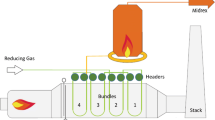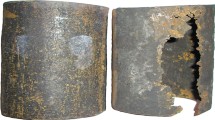Abstract
The heat exchange pipes in one synthetic ammonia plant were in use for only thirteen months, but obvious leakage occurred in the pipes. Investigations indicated that corrosion of the pipes was quite serious, resulting in corrosion pits penetrating the pipes in some spots. Analysis on the metallurgical structure indicated that no problems existed on the pipe material AISI 1020 low carbon steel; the corrosion inhibitors or scale inhibitors were added in the circulating water. The only problem was deduced to exist in the maintenance of the pipes during the idling period; survey of the maintenance of the pipes during the idling period proved the deduction above. Since no effective measures were taken to protect the pipes in the coolers and the circulating water was not emptied, the corrosion products and scales deposited on the pipes and formed local occluded cells; the occluded cells accelerated the pitting corrosion of the pipes and induced leakage in a short time.







Similar content being viewed by others
References
J. Dejun, Present situation and development of technology for ammonia synthetic process. Mod. Chem. Ind. 08, 9–14 (2005)
Y. Liang, B. Ji, Failure analysis of corrosion leakage for oil pipeline. Surf. Technol. 08, 68–73 (2016)
Y. Zhang, M. Xu, X. Liu, L. Guo, Y. Guo, L. Wang, H. Wang, Corrosion perforation failure analysis of a natural gas pipeline. Total Corros. Control 04, 65–67 (2013)
Y. Zhang, Y. Li, Y. Chen, Failure analysis on cracking of hydrogenation reactor distillate lead-out pipeline. Petro-Chem. Equip. 01, 96–98 (2011)
Q. Ma, S. You, J. Jia, L. An, Surficial aluminizing of AISI 1020 steel in molten salts and aluminizing mechanism. J. Lanzhou Univ. Technol. 03, 10–12 (2010)
M. Cui, X. Cao, Z. Feng, Corrosion pit morphology on the impact of oil and gas pipeline failure pressure. J. Ship Mech. Z1, 124–131 (2014)
J. Zhang, Tahe oilfield gas pipeline corrosion characteristics and rules. Sci. Technol. Rev. 31, 65–70 (2014)
H. Hu, M. Li, Study on corrosion mechanism and protection of buried oil and gas pipeline. J. Oil Gas Technol. 06, 367–368 (2008)
T. Ma, H. Zhang, The corrosion mechanism of oil and gas pipelines. Chem. Eng. Equip. 11, 121–122 (2009)
Y. Niu, Study of the oil transportation pipeline corrosion and corrosion rate prediction. Pipeline Tech. Equip. 05, 45–47 (2011)
Z. Li, X. Shang, H. Hao, M. Wang, Y. Xie, Screening test methods for inhibitors used for oil and gas gathering pipelines. Corros. Prot. 03, 177–180 (2012)
Y. Xu, L. Wei, Z. Liu, A. Sun, J. Lin, Y. Xue, T. Li, J. Zhang, X. Zhang, D. Lei, Analysis of reasons for subsea pipeline perforation. Corros. Prot. 08, 683–687 (2016)
Author information
Authors and Affiliations
Corresponding author
Rights and permissions
About this article
Cite this article
Qiankun, Z., Yafei, S., Sixian, R. et al. Corrosion Failure Analysis on Heat Exchanger Pipes. J Fail. Anal. and Preven. 17, 349–353 (2017). https://doi.org/10.1007/s11668-017-0248-9
Received:
Revised:
Published:
Issue Date:
DOI: https://doi.org/10.1007/s11668-017-0248-9




